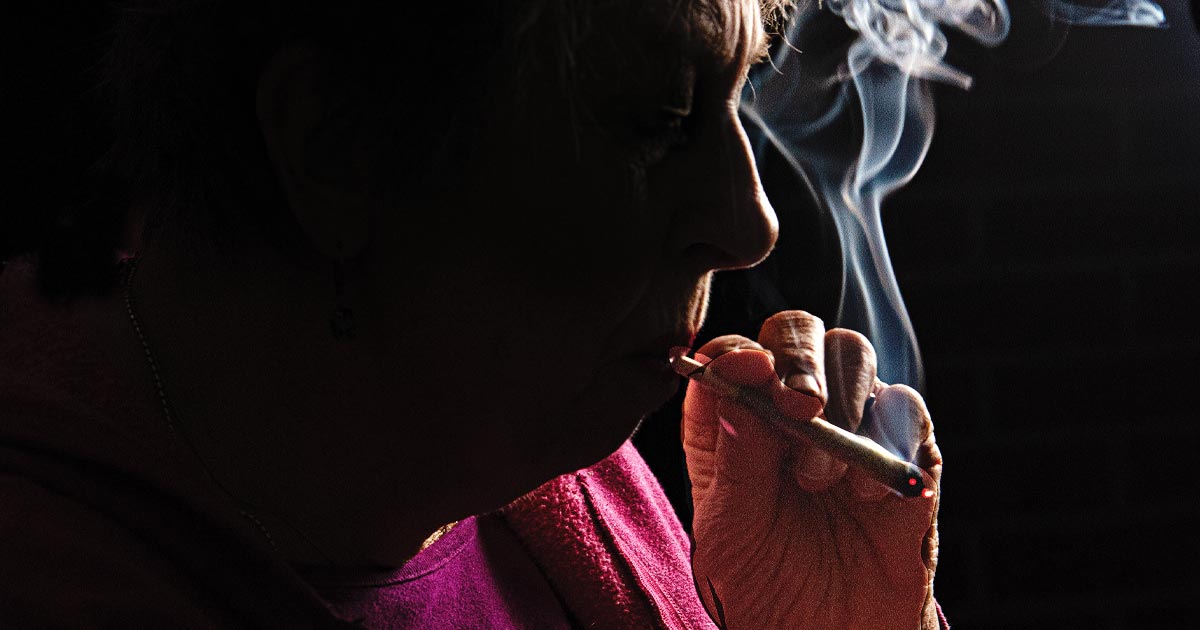This article contains affiliate links. As an Amazon Associate we earn from qualifying purchases.
By KEN LEVY
A majority of Montana voters approved the use of recreational marijuana when they passed Initiative 190 on the November 2020 ballot—with 57 percent of voters in favor and 43 percent opposed. The initiative became law under HB 701, signed by Gov. Greg Gianforte in May 2021. Now adults 21 and older may legally possess and use limited amounts of marijuana. Before you light up, make sure you understand the Montana marijuana law.
But just because it’s legal doesn’t mean you can buy or use it anywhere in the state. Pot is only allowed in the “green” counties where a majority of voters approved it, with most counties in central and southeastern Montana having voted against it. Those counties will not permit marijuana dispensaries to set up shop within their boundaries.
Recreational Use
In counties where voters said “aye,” legal use of recreational marijuana took effect this January. Adults can buy up to an ounce of marijuana products in a single transaction, including flower (the smokable part of the plant). This equals about 800 mg of edibles or 8 grams of concentrate.
The potency of these products is also regulated under the new law. Edible adult-use products, such as gummies (jellied candies infused with cannabis), can contain up to 10 mg of THC (tetrahydrocannabinol, the main psychoactive compound producing a high) per serving. A whole package cannot contain more than 100 mg of THC.
Marijuana flowers cannot exceed 35 percent THC, and marijuana products—like capsules, patches, or suppositories—can contain more than 100 mg of THC, but can’t exceed 800 mg in a full package.
Topical products are subject to the same maximum limitation, but cannot exceed 6 percent THC per dose.
Card Holders
Medical marijuana cardholders aren’t subject to these limits. They can purchase up to 5 ounces from dispensaries within a 30-day time period.
Avoiding Conviction
Buying larger quantities than those outlined in the statute is illegal. As well, driving under the influence can be treated just like an alcohol DUI. Anyone with more than 5 mg of THC in their blood is subject to conviction. First offense is a mandatory day in jail, with potential for up to six months imprisonment, and fines of up to $1,000.
If you’re carrying marijuana in your vehicle, it must be in its original, sealed packaging, away from the passenger areas of the vehicle, such as in the trunk or a locked glovebox.
Possession of more than an ounce of marijuana, up to 2 ounces, is considered an infraction, with fines up to $500. Possessing more than this is considered a felony, subject to as much as $45,000 in fines and up to five years in prison.
Consuming cannabis in public is an infraction, subject to a $50 fine.
Selling or delivering cannabis, unless you’re a licensed entity to do so, is a felony with particularly harsh consequences. Regardless of compensation, doing so in any amount carries a minimum one year in jail, and up to life imprisonment.
Private Cultivation
Adults can cultivate up to two mature marijuana plants and two seedlings for personal use in a private residence. Medical marijuana cardholders may cultivate up to four of each, but in all cases, the plants must remain hidden from public view.
Federal Law
Don’t get a buzz in Glacier or Yellowstone national parks. Federal law considers marijuana illegal, so you can’t legally get high in the parks, or even be in possession of cannabis products while on federal land.
Reduced Sentences
The law also authorizes the courts to reduce or eliminate sentences for marijuana offenses that became legal under the law, and to possibly expunge the offenses from individuals who have completed their sentences and have petitioned their local district court.
Commercial Licensure
For Montana counties allowing marijuana use, the legislation requires the Cannabis Control Division (CCD) of the Dept. of Revenue (DOR) to determine who gets licensing for distribution. Under the law, only those who already held licenses for medical marijuana distribution, along with those who had applied for licensure to distribute, prior to January 2022 can get licensed for growing and cultivating marijuana for adult use, at least until July 1, 2023.
Unlike alcohol license holders, who may sell their licenses to others, marijuana distributors may not transfer their licenses. As well, they have to keep their approval letters on site, so inspectors can check for compliance—they risk disciplinary proceedings if they don’t.
Tribal Licensure
The DOR may issue one license each to the eight federally recognized tribes located in Montana (or to businesses that are majority-owned by the tribe) for cultivation and sale, as long as they’re in a county that approved I-190.
Tax Revenues
Recreational marijuana sales will be taxed at 20 percent, with medical marijuana continuing at a 4 percent tax rate. A registered medical cardholder who cultivates their own plants will not have to pay a tax. Local jurisdictions can also add up to a 3-percent tax to sales.
Under the ballot language for the initiative, a net of $4 million from cannabis sales will go into a general fund. Anything over that amount will get distributed as follows:
$6 million per year for addiction treatment services;
20 percent of revenue to conservation;
4 percent of revenue—up to $650,000 each—to state parks, trails, recreational facilities, and wildlife protection;
$200,000 to veterans services and improving veterans’ cemeteries;
$300,000 to the purchase of drug detection dogs;
$150,000 for police training
At the time of this publication, the DOR reported January and February sales pulled in more than $6.3 million in tax revenue. Taxes and fees are expected to generate about $48 million a year by 2025.
Regulations
The CCD will also regulate commercial cultivation, production, distribution, and sales. They’ll require inspections of sales outlets and provide for marijuana testing by licensed laboratories that inspect for mold, heavy metals, bacteria, and other issues.
“Cannabis is much safer today than it was prior to (legalization),” said Eric Harding, operations manager for Lifted Meds. He said it was due in part to regulations and lab testing. “Not everybody grows good, clean cannabis. There are still farmers that will use pesticides that are systemic.”
State regulators will tell farmers if their products are not up to standards. Annual inspections are mandatory, and there is the potential for surprise inspections of cultivators’ and dispensaries’ product.
“Now that the Department of Revenue has taken over, I feel like the regulations will hold farmers to a higher standard,” he said.
Plants are tracked from the moment they’re seeds in a database through harvest. Every gram of the flower is tracked through state agencies.
Prior to changes in the law, “the medical marijuana program in Montana was vertically integrated: anything you [wanted] to sell at your dispensary had to be produced by your company,” Harding said.
With dispensaries in Missoula and Kalispell, Lifted Meds offers about 300 different cannabis items. Under the new law regarding recreational cannabis, Harding said he is able to find vendors specializing in specific products.
“Now we’re able to purchase from other vendors and not have to focus all of our effort on manufacturing every single product.”
Reversing Course
Counties can change their minds on legal adult sales either way with a new vote. Thus, any county with a majority opposed to legalized adult-use sales of recreational marijuana can hold a vote to legalize it, and vice versa.
September Rulemaking
Either way, look for yet more rules on how recreational marijuana is marketed. The DOR will institute rules pertaining to marijuana and cannabis product packaging and labeling during its rulemaking actions in September. Every licensed seller will have to apply for approval of the labeling of every product category they sell. They’ll be required to include photographs or graphics of the label design, product descriptions and proposed packaging, and, of course, pay fees for every label application. MSN









